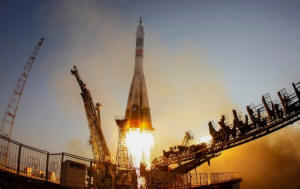|
Multinational crew blasts off for space
station
 Send a link to a friend
Send a link to a friend
 [July 07, 2016]
By Irene Klotz [July 07, 2016]
By Irene Klotz
(Reuters) - A three-member multinational
crew blasted off aboard a Russian Soyuz rocket from Kazakhstan on
Thursday for a two-day trip to the International Space Station, a NASA
TV broadcast showed.
NASA astronaut Kathleen "Kate" Rubins, Russian cosmonaut Anatoly
Ivanishin and Japanese astronaut Takuya Onishi lifted off from the
Baikonur Cosmodrome at 0136 GMT on Thursday (9:36p.m. EDT Wednesday)
and reached orbit nine minutes later.
"We wish you good luck," a Russian flight controller radioed to the
crew, an interpreter said.
The crew’s Russian Soyuz capsule is scheduled to arrive at the
station, which orbits about 250 miles (400 km) above Earth, at 0412
GMT Saturday (12:12 a.m. EDT) to begin a four-month mission.
"I’m incredibly excited about a lot of the biology experiments we’re
going to be doing," Rubins, 37, said in a NASA interview before
launch.
Rubins, a cancer and infectious diseases researcher, plans to
attempt the first DNA sequencing in orbit.
She, Ivanishin, 47, and Onishi, 41, will join NASA astronaut and
station commander Jeff Williams and two Russian cosmonauts who have
been aboard the orbital outpost since March.
 Ivanishin has made one previous flight to the station. Rubins and
Onishi are both rookie astronauts.
Thursday's launch marked the debut flight of a next-generation
Russian Soyuz capsule, currently the only vehicles capable of
ferrying crew members to and from the station, a $100 billion
project of 15 nations.
Upgrades to the Soyuz include better shielding to protect the
spacecraft from micrometeoroid and orbital debris impacts,
additional batteries, improved communications and tracking
equipment, new steering thrusters, larger solar arrays, an improved
rendezvous and docking system and a GPS-equipped landing system.
[to top of second column] |

The Soyuz MS spacecraft carrying the crew of Kate Rubins of the
U.S., Anatoly Ivanishin of Russia and Takuya Onishi of Japan blasts
off to the International Space Station (ISS) from the launchpad at
the Baikonur cosmodrome, Kazakhstan, July 7, 2016. REUTERS/Shamil
Zhumatov

NASA hopes to resume flying station crew members from the United
States in 2018 aboard capsules under development by Boeing Co and
privately owned Space Exploration Technologies, or SpaceX.
A docking system that the new commercial U.S. spaceships will need
to park at the station is scheduled to be launched aboard a SpaceX
cargo ship on July 18.
(Reporting by Irene Klotz in Cape Canaveral, Fla; Editing by Olzhas
Auyezov, Peter Cooney and Paul Tait)
[© 2016 Thomson Reuters. All rights
reserved.]
Copyright 2016 Reuters. All rights reserved. This material may not be published,
broadcast, rewritten or redistributed.
 |